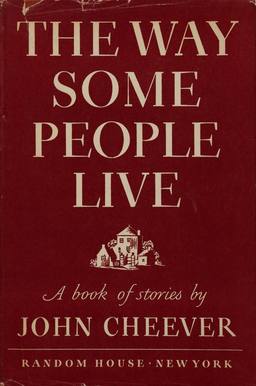"The Swimmer" is a short story by American author John Cheever. It was originally published in The New Yorker on July 18, 1964, and later in the short-fiction collections The Brigadier and the Golf Widow (1964) and The Stories of John Cheever (1978). Considered one of the author's most outstanding works, "The Swimmer" has received exhaustive analysis from critics and biographers.
The Five-Forty-Eight is a short story written by John Cheever that was originally published in the April 10, 1954, issue of The New Yorker and later collected in The Housebreaker of Shady Hill and Other Stories (1958) and The Stories of John Cheever (1978).

The Housebreaker of Shady Hill and Other Stories is a collection of short fiction by John Cheever. Composed of eight short stories, the volume was first published by Harper & Bros. in 1958. Reissued by Hillman/MacFadden in 1961, the works are included in The Stories of John Cheever (1978). The works were originally published individually in The New Yorker.
"The Hartleys" is a work of short fiction by John Cheever, first published in The New Yorker on January 22, 1949. The story was included in The Enormous Radio and Other Stories (1953), and in The Stories of John Cheever (1978).

The Enormous Radio and Other Stories is a collection of short fiction by John Cheever published in 1953 by Funk and Wagnalls. All fourteen stories were first published individually in The New Yorker. These works are included in The Stories of John Cheever (1978) published by Alfred A. Knopf.

The Way Some People Live is a collection of 30 works of short fiction by John Cheever, published in 1943 by Random House.

The Brigadier and the Golf Widow is a collection of short fiction by John Cheever, published by Harper and Row in 1964. These sixteen works were first published individually in The New Yorker. The works also appears in The Stories of John Cheever (1978).
"Goodbye, My Brother" is a short story by John Cheever, first published in The New Yorker, and collected in The Enormous Radio and Other Stories (1953). The work also appears in The Stories of John Cheever (1978).
"O Youth and Beauty!" is a short story by John Cheever first published in The New Yorker on August 22, 1953. The work was included the collection of Cheever's short fiction The Housebreaker of Shady Hill and Other Stories (1958) by Harper and Brothers. The story is also included in The Stories of John Cheever (1978).

Some People, Places and Things That Will Not Appear In My Next Novel is a collection of short fiction by John Cheever, published by Harper and Bros. in 1961. These nine short stories first appeared individually in The New Yorker or Esquire magazines. These works are included in the collection The Stories of John Cheever (1978), published by Alfred A. Knopf.

The World of Apples is the sixth collection of short fiction by author John Cheever, published in 1973 by Alfred A. Knopf. The ten stories originally appeared individually in The New Yorker, Esquire, The Saturday Evening Post or Playboy.
"Torch Song" is a short story by John Cheever which first appeared in The New Yorker on October 4, 1947. The work was included in the short fiction collection The Enormous Radio and Other Stories (1953), published by Funk and Wagnalls. "Torch Song" is included in The Stories of John Cheever (1978).
"The Country Husband" is a short story by John Cheever which first appeared in The New Yorker on November 20, 1954. The work was included in the collection of Cheever's short fiction The Housebreaker of Shady Hill and Other Stories (1958) published by Harper and Brothers. The story also appears in The Stories of John Cheever (1978).
"The Music Teacher" is a short story by John Cheever which first appeared in The New Yorker on November 21, 1959. The work was included in the short fiction collection The Brigadier and the Golf Widow (1964), published by Harper and Row. The story is one of Cheever's most anthologized works and is regarded as "a genuine masterpiece" of short fiction. "The Music Teacher" is included in The Stories of John Cheever (1978).
"The Seaside Houses" is a short story by John Cheever which first appeared in The New Yorker on July 29, 1961. The work was included in the short fiction collection The Brigadier and the Golf Widow (1964), published by Harper and Row.
"Publick House" is a short story by John Cheever which first appeared in The New Yorker on August 16, 1941. The work was included in the short fiction collection The Way Some People Live (1943), published by Random House.
"Expelled" is a short story by John Cheever published by The New Republic in 1930. The story appears in a collection of Cheever's short fiction, Thirteen Uncollected Stories by John Cheever, published in 1994 by Academy Chicago Publishers
"The Fourth Alarm" is a work of short fiction by John Cheever which first appeared in Esquire magazine in April 1970. The story was collected in The World of Apples, published in 1973 by Alfred A. Knopf.
"The World of Apples" is a work of short fiction by John Cheever, first appearing in Esquire, December 1966. The story was collected in the volume The World of Apples (1973), published by Alfred A. Knopf.
"Artemis, the Honest Well-Digger" is a work of short fiction by John Cheever, first appearing in Playboy magazine, January 1972. The story was collected in The World of Apples (1973), published by Alfred A. Knopf.